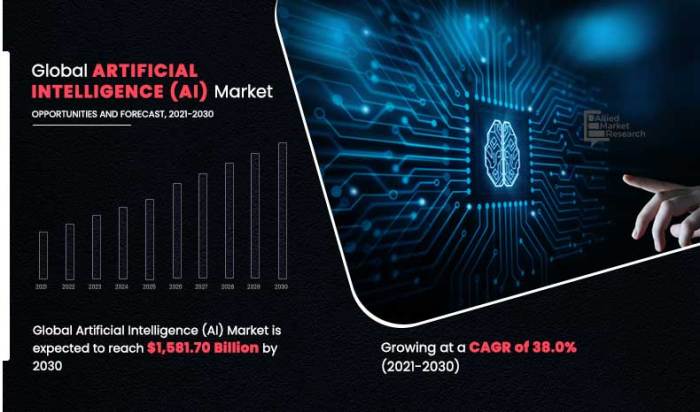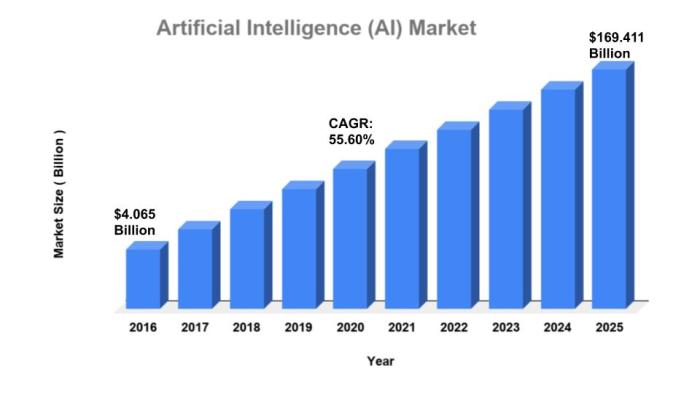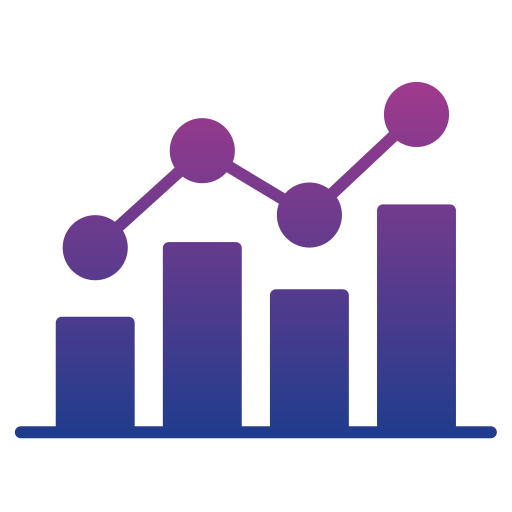AI-driven market analysis is revolutionizing how businesses understand their customers and markets. This innovative approach leverages the power of artificial intelligence to analyze vast amounts of data, uncovering hidden patterns and trends that traditional methods often miss. By harnessing the capabilities of machine learning, deep learning, and natural language processing, AI-driven market analysis empowers businesses to make data-driven decisions, optimize marketing strategies, and gain a competitive edge.
From identifying customer segments to predicting market trends, AI tools are transforming every aspect of market research. This shift is driven by the increasing availability of data, the advancements in AI algorithms, and the growing need for businesses to gain a deeper understanding of their customers and markets.
The Rise of AI in Market Research: AI-driven Market Analysis

The field of market research has undergone a dramatic transformation, moving away from traditional methods to embrace the power of AI-driven solutions. This shift has been fueled by the increasing availability of data, the need for faster insights, and the desire to uncover deeper customer understanding.
AI tools are revolutionizing how market research is conducted, enabling researchers to analyze vast amounts of data, identify patterns and trends, and make more accurate predictions.
AI Tools Transforming Market Research Practices, AI-driven market analysis
AI tools are significantly impacting market research practices, providing researchers with new capabilities and efficiencies. Here are some examples of how AI is transforming the field:
- Automated Data Collection:AI-powered tools can automate the process of collecting data from various sources, including social media, online reviews, and customer surveys. This allows researchers to gather data more efficiently and at scale.
- Sentiment Analysis:AI algorithms can analyze large volumes of text and social media data to understand customer sentiment, brand perception, and market trends. This provides valuable insights into consumer preferences and helps businesses make informed decisions.
- Predictive Analytics:AI models can analyze historical data to predict future market trends, consumer behavior, and product demand. This allows businesses to anticipate market shifts and make proactive decisions.
- Personalized Recommendations:AI algorithms can analyze customer data to provide personalized recommendations for products and services. This enhances customer experience and drives sales.
A Brief History of AI Applications in Market Research
The use of AI in market research has evolved over time, with key milestones and breakthroughs shaping its current landscape.
- Early Applications (1980s-1990s):The initial applications of AI in market research focused on tasks like data analysis and statistical modeling. Expert systems were developed to provide insights into specific market segments.
- Rise of Machine Learning (2000s-2010s):The advent of machine learning algorithms enabled more sophisticated analysis of large datasets. This led to the development of tools for sentiment analysis, customer segmentation, and predictive modeling.
- Deep Learning Revolution (2010s-Present):Deep learning techniques have further enhanced AI capabilities in market research. This has resulted in more accurate predictions, better understanding of complex customer behavior, and improved personalization strategies.
Key Applications of AI-Driven Market Analysis

AI is transforming the way businesses understand and engage with their target markets. By leveraging machine learning, natural language processing, and other advanced technologies, AI-driven market analysis empowers businesses to gain deeper insights, make more informed decisions, and achieve better results.
Customer Segmentation
Customer segmentation is the process of dividing a customer base into groups with similar characteristics. This allows businesses to tailor their marketing and sales efforts to each segment, leading to increased efficiency and effectiveness. AI can be used to automate and enhance customer segmentation in several ways.
- Data Collection and Analysis:AI can analyze vast amounts of customer data from various sources, including CRM systems, website analytics, social media, and transactional data. This allows for a more comprehensive and accurate understanding of customer behavior and preferences.
- Clustering Algorithms:AI algorithms, such as k-means clustering and hierarchical clustering, can automatically group customers based on their similarities. This eliminates the need for manual analysis and ensures that segmentation is based on objective data rather than subjective assumptions.
- Dynamic Segmentation:AI can dynamically adjust customer segments based on changing customer behavior and market conditions. This ensures that marketing campaigns remain relevant and effective over time.
Benefits:
- Improved Targeting:AI-driven segmentation allows businesses to target their marketing and sales efforts more effectively, reaching the right customers with the right message at the right time.
- Personalized Experiences:By understanding individual customer preferences, businesses can personalize their marketing messages, product recommendations, and customer service interactions.
- Increased Revenue:Targeted marketing and personalized experiences lead to higher conversion rates, increased customer loyalty, and ultimately, higher revenue.
Examples:
- Netflix:Netflix uses AI to segment its customer base based on viewing history, preferences, and demographics. This allows them to recommend personalized content and improve customer satisfaction.
- Amazon:Amazon leverages AI to segment its customers based on their purchase history, browsing behavior, and search queries. This enables them to offer targeted product recommendations and personalized shopping experiences.
AI Techniques for Market Analysis
AI techniques are transforming market analysis by providing powerful tools to extract insights from vast datasets, predict consumer behavior, and optimize marketing strategies. These techniques leverage algorithms to automate tasks, analyze patterns, and generate actionable insights, offering a significant advantage over traditional methods.
Machine Learning
Machine learning is a core AI technique that enables computers to learn from data without explicit programming. It involves training algorithms on large datasets to identify patterns and make predictions. In market research, machine learning algorithms can be used to segment customers, predict product demand, and personalize marketing campaigns.Machine learning algorithms are broadly categorized into supervised, unsupervised, and reinforcement learning.
Supervised learning algorithms are trained on labeled data, where each data point has a corresponding output. Unsupervised learning algorithms are trained on unlabeled data, where the algorithm must discover patterns and structures in the data. Reinforcement learning algorithms learn by interacting with their environment and receiving rewards for taking actions that lead to desired outcomes.
- Supervised learningalgorithms are used in market analysis for tasks such as customer segmentation, churn prediction, and price optimization. For instance, a supervised learning algorithm can be trained on historical customer data to identify factors that contribute to churn, such as demographics, purchase history, and customer service interactions.
This information can then be used to develop targeted retention strategies.
- Unsupervised learningalgorithms are useful for market analysis tasks such as customer clustering, anomaly detection, and market basket analysis. For example, an unsupervised learning algorithm can be used to identify groups of customers with similar buying habits, which can then be used to develop targeted marketing campaigns.
- Reinforcement learningalgorithms are increasingly being used in market analysis for tasks such as dynamic pricing, personalized recommendations, and automated marketing campaigns. For example, a reinforcement learning algorithm can be trained to adjust prices based on real-time demand fluctuations, leading to increased revenue and improved customer satisfaction.
Deep Learning
Deep learning is a subfield of machine learning that uses artificial neural networks with multiple layers to extract complex features from data. These networks are inspired by the structure and function of the human brain and are particularly well-suited for analyzing unstructured data, such as images, text, and audio.Deep learning techniques have numerous applications in market research, including sentiment analysis, image recognition, and predictive modeling.
For instance, deep learning algorithms can be trained on social media data to analyze consumer sentiment towards a product or brand, providing valuable insights for marketing campaigns.
- Sentiment analysisis a key application of deep learning in market research, enabling businesses to understand consumer opinions and emotions towards their products, services, and brand. Deep learning models can analyze large volumes of text data from social media, reviews, and forums to identify positive, negative, or neutral sentiment, providing valuable insights for marketing and product development.
- Image recognitionis another crucial application of deep learning in market research, enabling businesses to analyze images and videos to understand consumer behavior, product preferences, and brand perception. Deep learning models can be trained on images of products, stores, and advertisements to identify patterns and trends, providing insights for marketing, product design, and retail analytics.
- Predictive modelingis a powerful application of deep learning in market research, enabling businesses to forecast future trends and make informed decisions. Deep learning models can analyze historical data and identify patterns to predict future demand, customer behavior, and market trends, providing insights for inventory management, pricing, and marketing strategies.
Natural Language Processing
Natural language processing (NLP) is a field of AI that focuses on enabling computers to understand and process human language. NLP techniques are used in market research to analyze text data, such as customer reviews, social media posts, and marketing materials.
NLP algorithms can extract key information from text, identify sentiment, and understand the context of language.NLP techniques have numerous applications in market research, including sentiment analysis, topic modeling, and text summarization. For instance, NLP algorithms can be used to analyze customer reviews to identify common themes and sentiments, providing valuable insights for product improvement and customer service.
- Sentiment analysisis a key application of NLP in market research, enabling businesses to understand consumer opinions and emotions towards their products, services, and brand. NLP models can analyze large volumes of text data from social media, reviews, and forums to identify positive, negative, or neutral sentiment, providing valuable insights for marketing and product development.
- Topic modelingis another crucial application of NLP in market research, enabling businesses to identify key themes and topics discussed in large volumes of text data. NLP models can analyze text data from customer reviews, social media posts, and news articles to identify recurring themes and topics, providing insights for market research, product development, and brand management.
- Text summarizationis a powerful application of NLP in market research, enabling businesses to condense large volumes of text data into concise summaries. NLP models can analyze text data from reports, articles, and customer reviews to generate summaries that highlight key information and insights, providing valuable information for decision-making.
Computer Vision
Computer vision is a field of AI that enables computers to “see” and interpret images and videos. Computer vision techniques are used in market research to analyze visual data, such as product images, store layouts, and customer behavior in retail environments.
Computer vision algorithms can identify objects, track movement, and understand the context of images.Computer vision techniques have numerous applications in market research, including product recognition, visual search, and customer behavior analysis. For instance, computer vision algorithms can be used to analyze images of products to identify key features and attributes, providing valuable insights for product development and marketing.
- Product recognitionis a key application of computer vision in market research, enabling businesses to identify and classify products in images and videos. Computer vision models can analyze images of products on shelves, in advertisements, and on social media to identify specific products, brands, and categories, providing insights for market research, product placement, and advertising effectiveness.
- Visual searchis another crucial application of computer vision in market research, enabling businesses to search for products and information based on images. Computer vision models can analyze images of products to identify key features and attributes, allowing users to search for similar products or information based on visual cues, providing a more intuitive and engaging search experience.
- Customer behavior analysisis a powerful application of computer vision in market research, enabling businesses to understand how customers interact with products and services in physical retail environments. Computer vision models can analyze videos of customers in stores to track their movement, identify products they interact with, and understand their shopping behavior, providing insights for store layout optimization, product placement, and customer experience improvement.
Benefits and Challenges of AI-Driven Market Analysis
The integration of Artificial Intelligence (AI) into market research has brought about a paradigm shift, offering a plethora of benefits while also presenting certain challenges. Understanding both the advantages and drawbacks of AI-driven market analysis is crucial for organizations seeking to leverage this transformative technology effectively.
Advantages of AI-Driven Market Analysis
AI-powered market analysis offers significant advantages over traditional methods, leading to more accurate, efficient, and insightful decision-making.
- Enhanced Accuracy:AI algorithms can analyze vast datasets with unparalleled speed and precision, identifying patterns and trends that might be missed by human analysts. This leads to more accurate market forecasts, customer segmentation, and competitive analysis. For instance, AI can analyze millions of social media posts to identify emerging consumer trends, providing a more accurate understanding of market sentiment than manual analysis could achieve.
- Increased Efficiency:AI automates repetitive tasks, such as data cleaning, analysis, and report generation, freeing up market research professionals to focus on higher-level activities like strategic planning and interpretation. This translates into faster turnaround times and reduced costs for market research projects.
For example, AI-powered tools can automatically analyze customer feedback data, identifying key themes and insights, significantly reducing the time and effort required for manual analysis.
- Unveiling Deeper Insights:AI algorithms can uncover hidden relationships and patterns within data that might not be apparent to human analysts. This enables market researchers to gain deeper insights into customer behavior, market dynamics, and competitive landscapes. For example, AI can analyze customer purchase data to identify hidden correlations between product features and customer preferences, leading to more targeted product development and marketing strategies.
Challenges of AI-Driven Market Analysis
While AI offers significant advantages, its implementation in market analysis also presents several challenges that organizations must address.
- Data Quality:AI algorithms are only as good as the data they are trained on. Poor data quality can lead to inaccurate insights and biased results. Organizations must ensure that their data is clean, accurate, and representative of the target market.
For example, if an AI algorithm is trained on biased data, it may perpetuate those biases in its analysis, leading to inaccurate conclusions about market trends or customer preferences.
- Model Interpretability:Many AI models, particularly deep learning algorithms, are considered “black boxes” – their decision-making processes are difficult to understand. This lack of transparency can make it challenging to interpret the results and ensure their validity. For example, if an AI model predicts a decline in demand for a particular product, it can be difficult to understand the reasons behind this prediction, making it difficult to take appropriate action.
- Ethical Considerations:The use of AI in market analysis raises ethical concerns, such as data privacy, algorithmic bias, and the potential for job displacement. Organizations must ensure that their AI-driven market analysis practices are ethical and responsible. For example, organizations must obtain informed consent from customers before using their data for AI-driven analysis, and they must be transparent about how AI is being used in their market research activities.
Future Trends in AI-Driven Market Analysis
The field of AI-driven market analysis is constantly evolving, with new trends emerging that promise to revolutionize how we understand and predict market behavior. These trends are driven by advancements in AI algorithms, the increasing availability of data, and the integration of AI with other technologies.
Advanced Algorithms
The development of more sophisticated AI algorithms is a key driver of innovation in market analysis. These algorithms are capable of handling increasingly complex datasets and identifying patterns that might be missed by human analysts. For example, deep learning algorithms are being used to analyze unstructured data, such as social media posts and customer reviews, to gain insights into consumer sentiment and preferences.
Reinforcement learning algorithms are being used to optimize marketing campaigns and personalize customer experiences.
Integration with Other Technologies
AI-driven market analysis is increasingly being integrated with other technologies, such as the Internet of Things (IoT) and blockchain. IoT devices generate vast amounts of data about consumer behavior, which can be analyzed by AI algorithms to provide real-time insights into market trends.
Blockchain technology can be used to create secure and transparent data sharing platforms, enabling businesses to collaborate on market research projects and share insights.
New Applications
AI is also being used to develop new applications for market analysis, such as predictive analytics and sentiment analysis. Predictive analytics uses AI algorithms to forecast future market trends, enabling businesses to make informed decisions about product development, pricing, and marketing strategies.
Sentiment analysis uses AI to analyze customer feedback and social media data to understand public perception of brands and products.
Ethical Implications
As AI-driven market analysis becomes more sophisticated, it is important to consider the ethical implications of these technologies. For example, the use of AI to target advertising can raise concerns about privacy and data security. It is essential that businesses use AI in a responsible and ethical manner, ensuring that data is collected and used in a transparent and accountable way.
Last Point
The future of market analysis lies in the hands of AI. As AI technologies continue to evolve, we can expect even more sophisticated applications and insights. By embracing AI-driven market analysis, businesses can unlock new opportunities, navigate market complexities, and stay ahead of the curve.
This powerful tool empowers organizations to make informed decisions, optimize their strategies, and ultimately achieve greater success.
Question & Answer Hub
What are the key benefits of AI-driven market analysis?
AI-driven market analysis offers several benefits, including improved accuracy, efficiency, and insights. It can analyze vast amounts of data, identify hidden patterns, and provide more accurate predictions than traditional methods. This leads to better decision-making, more effective marketing campaigns, and a deeper understanding of customer behavior.
What are the challenges associated with AI-driven market analysis?
While AI-driven market analysis offers significant advantages, it also presents some challenges. These include ensuring data quality, interpreting complex AI models, and addressing ethical considerations related to data privacy and bias. Overcoming these challenges is crucial for realizing the full potential of AI in market research.
How can businesses get started with AI-driven market analysis?
Businesses can start by identifying their specific needs and goals for market analysis. They should then explore available AI tools and platforms, considering their budget and technical expertise. It’s also important to develop a clear data strategy and ensure data quality.
Finally, businesses should collaborate with experts in AI and market research to implement and optimize their AI-driven solutions.
